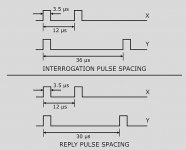Edelweiss
Author of: Scanning the UK Airbands with the Beast
I had this idea some time ago and not sure if it's already been done. I suppose most MIL a/c will have their TACAN running when not operating covertly, and we're probably interested in those which do not show up on a tracker. Has anybody tried intercepting their TACAN downlink signals successfully? I tried tuning into it with an SDR but get quite a lot of local interference probably from all things computer so I'm not sure if I caught something. The transponder signal should come in reasonably strong with good range I would have thought, so far no luck even with those who claimed doing a TACAN approach. The pulses are of course very short and that might be the issue here. Should be some irregular chirps? I'm quite certain I was on the right channel. Need to play more but if you have any contributions please post them here!
Mike
Mike



